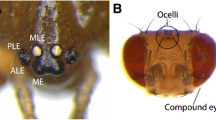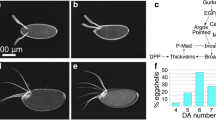Abstract
Hypercephaly, in the form of lateral extensions of the head capsule, is observed in several families of Diptera. A particularly exaggerated form is found in Diopsid stalk-eyed flies, in which both eyes and antennae are laterally displaced at the end of stalks. The processes of early development and specification of the head capsule in stalk-eyed flies are similar to those in Drosophila melanogaster. In Drosophila the homeobox gene ocelliless (oc) shows a mediolateral gradient of expression across the region of the eye-antennal imaginal disc that gives rise to the head capsule and specifies the development of different head structures. The genes and developmental mechanisms that subsequently define head shape in Drosophila and produce hypercephaly in stalk-eyed flies remain unclear. To address this, we performed an enhancer trap screen for Drosophila genes expressed in the same region as oc and identified the homeobox gene defective proventriculus (dve). In the eye-antennal imaginal disc, dve is coexpressed with oc in the region that gives rise to the head capsule and is active along the medial edge of the antennal disc and in the first antennal segment. Analyses of dve expression in mutant eye-antennal discs are consistent with it acting downstream of oc in the development of the head capsule. We confirm that orthologues of dve are present in a diverse panel of five stalk-eyed fly species and analyse patterns of dve sequence variation within the clade. Our results indicate that dve expression and sequence are both highly conserved in stalk-eyed flies.





Similar content being viewed by others
References
Amin A, Finkelstein R (2000) Epidermal growth factor receptor signalling activates orthodenticle expression during Drosophila head development. DNA Cell Biol 19:631–638
Amin A, Li Y, Finkelstein R (1999) Hedgehog activates the EGF receptor pathway during Drosophila head development. Development 126:2623–2630
Baker RH, Ashwell RIS, Richards TA, Fowler K, Chapman T, Pomiankowski A (2001) Effects of multiple mating and male eyespan on female reproductive output in the stalk-eyed fly, Cyrtodiopsis dalmanni. Behav Ecol 12:732–739
Bürglin TR, Cassatta G (2002) Loss and gain of domains during evolution of cut superclass homeobox genes. Int J Dev Biol 46:115–123
Burkhardt D, de la Motte I (1988) Big “antlers” are favoured: female choice in stalk-eyed flies (Diptera, Insecta), field collected harems and laboratory experiments. J Comp Physiol A 162:649–652
Buschbeck EK, Hoy RR (1998) Visual system of the stalk-eyed fly, Cyrtodiopsis quinqueguttata (Diopsidae, Diptera): an anatomical investigation of unusual eyes. J Neurobiol 37:449–468
Fuss B, Hoch M (1998) Drosophila endoderm development requires a novel homeobox gene which is a target of Wingless and Dpp signaling. Mech Dev 79:83–97
Haynie JL, Bryant PJ (1986) Development of the eye-antenna imaginal disc and morphogenesis of the adult head in Drosophila melanogaster. J Exp Zool 237:293–308
Hingle A, Fowler K, Pomiankowski A (2001) Size-dependent mate preference in the stalk-eyed fly, Cyrtodiopsis dalmanni. Anim Behav 61:589–595
Hurley I, Fowler K, Pomiankowski A, Smith H (2001) Conservation of the expression of Dll, en, and wg in the eye-antennal imaginal disc of stalk-eyed flies. Evol Dev 3:408–414
Hurley I, Pomiankowski A, Fowler K, Smith H (2002) Fate map of the eye-antennal imaginal disc in the stalk-eyed fly Cyrtodiopsis dalmanni. Dev Genes Evol 212:38–42
Klein T, Martinez-Arias AM (1999) The vestigial gene product provides a molecular context for the interpretation of signals during the development of the wing in Drosophila. Development 126:913–925
Kolzer S, Fuss B, Hoch M, Klein T (2003) defective proventriculus is required for pattern formation along the proximodistal axis, cell proliferation and formation of veins in the Drosophila wing. Development 130:4135–4147
Nakagoshi H, Hoshi M, Nabeshima Y, Matsuzuki F (1998) A novel homeobox gene mediates the Dpp signal to establish functional specificity within target cells. Genes Dev 12:2724–2734
Nakagoshi H, Shirai T, Nabeshima Y, Matsuzaki F (2002) Refinement of wingless expression by a wingless- and notch-responsive homeodomain protein, defective proventriculus. Dev Biol 249:44–56
Royet J, Finkelstein R (1995) Pattern formation in Drosophila head development; the role of the orthodenticle homeobox gene. Development 121:3561–3572
Royet J, Finkelstein R (1996) hedgehog, wingless and orthodenticle specify adult head development in Drosophila. Development 122:1849–1858
Shirai T, Maehara A, Kiritooshi N, Matsuzaki F, Handa H, Nakagoshi H (2003) Differential requirement of EGFR signaling for the expression of defective proventriculus gene in the Drosophila endoderm and ectoderm. Biochem Biophys Res Commun 311:473–477
Strimmer K, von Haessler A (1996) Quartet puzzling: a quartet maximum-likelihood method for reconstructing tree topologies. Mol Biol Evol 13:964–969
Swofford DL (2002) PAUP*. Phylogenetic analysis using parsimony (*and other methods). Version 4. Sinauer Associates, Sunderland, MA
Thomas C, Ingham PW (2003) Hedgehog signaling in the Drosophila eye and head: an analysis of the effects of different patched trans-heterozygotes. Genetics 165:1915–1928
Thompson JD, Gibson TJ, Plewniak F, Jeanmougin F, Higgins DG (1997) The CLUSTAL_X windows interface: flexible strategies for multiple sequence alignment aided by quality analysis tools. Nucleic Acids Res 25:4876–4882
Wieschaus E, Perrimon N, Finkelstein R (1992) orthodenticle activity is required for the development of medial structures in the larval and adult epidermis of Drosophila. Development 115:801–811
Wilkinson GS, Dodson GN (1997) Function and evolution of antlers and stalks in flies. In: Choe J, Crespi B (eds) The evolution of mating systems in insects and arachnids. Cambridge University Press, Cambridge, pp 310–327
Yang Z (1997) PAML: a program package for phylogenetic analysis by maximum likelihood. Comput Appl Biosci 13:555–556
Acknowledgements
We thank Gerald Wilkinson for providing samples of C. quinqueguttata, D. dubia, D. signata and S. beccarii, the Bloomington Stock Center for providing fruit fly stocks, the MRCgeneservice for supplying DGC cDNA clones and H. Nakagoshi for supplying anti-DVE antiserum. We also thank Sara Goodacre and Richard Emes for help in running the PAML programme, and Matthew Denniff and Sam Cotton for their assistance and support during this study. This research was funded by awards from the Biotechnology and Biological Sciences Research Council (to K.F., A.P. and H.S.) and the Natural Environment Research Council (studentship to I.H.).
Author information
Authors and Affiliations
Corresponding author
Additional information
Communicated by P. Simpson
M. Carr and I. Hurley contributed equally to this work.
Rights and permissions
About this article
Cite this article
Carr, M., Hurley, I., Fowler, K. et al. Expression of defective proventriculus during head capsule development is conserved in Drosophila and stalk-eyed flies (Diopsidae). Dev Genes Evol 215, 402–409 (2005). https://doi.org/10.1007/s00427-005-0488-7
Received:
Accepted:
Published:
Issue Date:
DOI: https://doi.org/10.1007/s00427-005-0488-7




